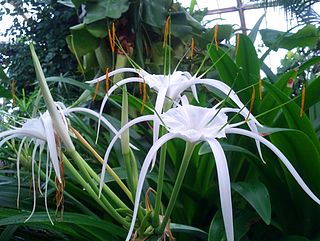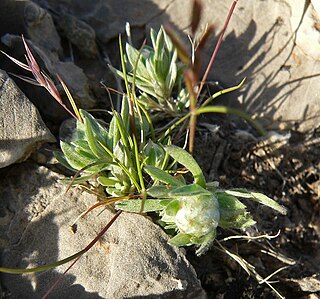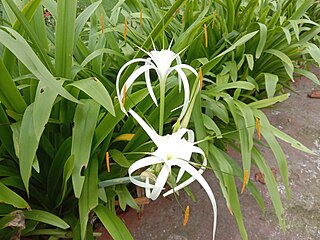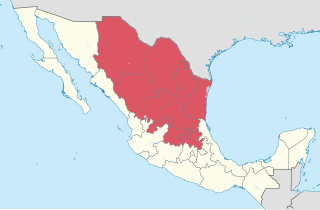
Hermosillo, formerly called Pitic, is a city located in the center of the northwestern Mexican state of Sonora. It is the municipal seat of the Hermosillo municipality, the state's capital and largest city, as well as the primary economic center for the state and the region. As of 2020, the city has a population of 936,263, making it the 18th largest city in Mexico. The recent increase in the city's population is due to expanded industrialization, especially within the automotive industry.

The Sonoran Desert is a desert in North America and ecoregion that covers the northwestern Mexican states of Sonora, Baja California, and Baja California Sur, as well as part of the southwestern United States. It is the hottest desert in both Mexico and the United States. It has an area of 260,000 square kilometers (100,000 sq mi).

Washingtonia robusta, known by common name as the Mexican fan palm, Mexican washingtonia, or skyduster is a palm tree native to the Baja California peninsula and a small part of Sonora in northwestern Mexico. Despite its limited native distribution, W. robusta one of the most widely cultivated subtropical palms in the world. It is naturalized in Florida, California, Nevada, Arizona, New Mexico, Hawaii, Texas, parts of the Canary Islands, Spain, Portugal, France, Italy, Malta, Albania, Greece, Turkey, Cyprus, Israel, Palestine, Jordan, Lebanon, Syria, Iraq, Saudi Arabia, Bahrain, Qatar, United Arab Emirates, Oman, Yemen, Iran, Afghanistan, Egypt, Libya, Tunisia, Algeria, Morocco, and Réunion,.

Hymenocallis (US) or (UK) is a genus of American plants in the amaryllis family.

Hymenocallis coronaria, commonly known as the Cahaba lily, shoal lily, or shoals spider-lily, is an aquatic, perennial flowering plant species of the genus Hymenocallis. It is endemic to the Southeastern United States, being found only in Alabama, Georgia, South Carolina and parts of North Carolina. Within Alabama, it is known as the Cahaba lily; elsewhere it is known as the Shoal lily or Shoals spider-lily.

Stylocline(neststraw) is a small genus of North American desert plants in the tribe Gnaphalieae within the family Asteraceae.

Flaveria is a genus of plants in the family Asteraceae. They are sometimes called yellowtops. Some are annual or perennial herbs and some are shrubs. They bear yellow flowers in heads, with zero, one, or two ray florets in each head. These plants are found in the Americas, Asia, Africa, and Australia.

Hymenocallis littoralis, commonly known as the beach spider lily, is a species of plant in the amaryllis family Amaryllidaceae. It is native to warmer coastal regions of Latin America and a widely cultivated and naturalized plant in many tropical countries.

Ceratomia sonorensis, the Sonoran sphinx, is a moth of the family Sphingidae. It is known from high altitudes in oak and oak-pine associations in Madrean woodland in Sonora, Mexico and in south-eastern Arizona.
Prodoxus sonorensis is a moth of the family Prodoxidae. It is found in south-eastern Arizona, United States, and south into northern Sonora, Mexico.

Hymenocallis pimana is a member of the genus Hymenocallis, in the family Amaryllidaceae. Common name in English is Pima spider-lily; in Spanish it is cebollín. It is endemic to a small mountainous region in the Sierra Madre Occidental, straddling the Mexican states of Chihuahua and Sonora. Many of the people of the region are of the indigenous group known as the Mountain Pima or Pima Bajo.
Hymenocallis clivorum is a member of the genus Hymenocallis, of the plant family Amaryllidaceae. It is native to the southern part of the Mexican state of Sonora.

Mammillaria standleyi is a species of the family Cactaceae native to the Sierra Madre Occidental of Sinaloa, Chihuahua and Sonora. It has red-purple flowers surrounded by cottony pubescence. Fruits are red and edible, tasting like apples, although too small to be of much food value to humans.

Yepáchic, sometimes spelled Yepáchi, is a community in the western part of the Mexican State of Chihuahua, approximately 10 km (6.2 mi) east of the boundary with the State of Sonora. It is located in the Municipio de Temósachic at an altitude of 1,780 meters (5,840 ft) in the Sierra Madre Occidental. Many of the people of the region are members of the indigenous ethnic group called Mountain Pima or the Pima Bajo. They are related to the Pima and Papago of Arizona and northern Sonora, speaking a similar but distinct language.

Hymenocallis occidentalis is a plant species native to the southern United States. It is known along the Gulf Coast from South Carolina to Texas, and in the Mississippi Valley as far north as southern Illinois and Indiana. It is also cultivated as an ornamental elsewhere because of its showy, sweet-smelling flowers. Common names include woodland spider-lily, hammock spider-lily or northern spider-lily.

Hymenocallis eucharidifolia is a rare plant in the plant in the Amaryllidaceae. It is native to rainforests in the Mexican states of Oaxaca and Guerrero.
Hymenocallis durangoensis is a plant species endemic to the Mexican state of Durango. It is a bulb-forming herb with white flowers.

Hymenocallis imperialis, common name Big Fatty, is a plant species native to the Mexican states of San Luis Potosí and Hidalgo. It is also cultivated in other regions as an ornamental.

Hymenocallis acutifolia is a plant species first described in 1826 with the name Hymenocallis littoralis var. acutifolia. It is endemic to Mexico, known from the States of Oaxaca, Michoacán, Jalisco, Veracruz, Puebla, and Nayarit.
Flaveria sonorensis is a rare Mexican plant species of Flaveria within the family Asteraceae. It has been found only in southern Sonora and southwestern Chihuahua in northwestern Mexico. Some of the populations lie very close to hot mineral springs.















